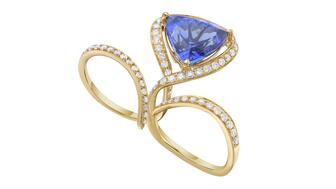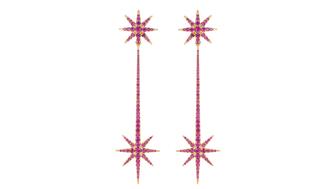Carlos Jose Hernandez and Joshua Zuazo were sentenced to life without the possibility of parole in the 2024 murder of Hussein “Sam” Murray.
50 Jewelers/50 States: Connecticut
Soon to reach 120 years in business, one of the keys to Lux Bond & Green’s success is being open to changing with the times.

West Hartford, Conn.--Amid the changing and challenging retail environment, the editorial team at National Jeweler wondered how macro trends--from online shopping to serving new generations of consumers--have affected jewelers in disparate parts of the country.
In order to find out, we launched a series called 50 Jewelers/50 States, in which we interview one retailer in each of the 50 U.S. states.
Connecticut retailer Lux Bond & Green opened in 1898 under the leadership of M.A. Green.
Nearly 120 years later, Green’s great-grandson, John A. Green, who joined the family business in 1978, is the president and CEO.
Today, Lux Bond & Green has six store locations, four in Connecticut and two in Massachusetts.
Green spoke to National Jeweler about the importance of staying open-minded and embracing new methods of communication.

National Jeweler: What’s the biggest challenge your store is facing?
John A. Green: I think the same thing that challenges every brick-and-mortar business today: evolving your business in today’s new retail world.
People’s habits are changing, the way people shop is changing, the way we do business is changing, and we have to bring a great professional staff into those changes.
My challenge really is bringing 90-plus people into the new retail world.
NJ: What’s the top-selling item or brand at your store?
JAG: The two-top selling categories are definitely bridal and watches.
NJ: What’s the most popular style of engagement ring with your clientele?
JAG: The round brilliant is still our bread-and-butter engagement ring, ranging from 1 1/2 to 2 carats. We pay close attention to the beauty and value of the gemstone.
Our customers’ favorite setting is always platinum with brilliant diamonds on the side and most ladies prefer four prongs set low. It’s both practical and beautiful.
NJ: Describe your regional customer.
JAG: The customer is changing. In the olden days the customer was a well-established and well-educated business man or woman who loved great values and great designs from a name that they could trust.
That’s yesterday. Every day it’s different.
Today it’s going to be a combination of a very young person or a very old person who wants to be treated with respect and wants
So everything we knew in the past is out the window except our core values: Respect, confidentiality, quality, value and exceptional service.
Some people still want a phone call, some people still want an e-mail, some people want a text, some people want communication in the form of a letter, and some people want you to come to their office or their home. So we need to ask them because everyone is different today.
Some people say, “Just leave a message on my voicemail.” It’s amazing. And it’s not necessarily age specific except for probably with the younger age category, which will most likely prefer a text.
In the olden days how did you communicate with somebody? You did a radio commercial or you did an ad in a physical newspaper, that’s how you communicated with people. You didn’t call them up, you didn’t write to them, you unlocked your front door and you waited for them to come in.
If you do that today, you’re dead.
A post shared by Lux Bond & Green (@luxbondgreen) on Feb 26, 2017 at 2:28pm PST
NJ: What’s your internet and social media presence like? What accounts do you have or actively use?
JAG: We’re actively using Instagram and Facebook and we’ve had an internet store tied to our inventory for 15 years. I guess we were--in our own very small way--leaders in that category and it’s evolving daily because it has to.
It’s very difficult to measure which platform is the most successful for us. Advertising and marketing have always been difficult to measure.
With all of the analytics that we’re getting today I actually think it’s even more difficult to measure. Although you can sit there and look (at different figures), true measurements are at the end of the month. The question is, “Did you have a good month?” Not, “How many people opened your e-blast or how many sales did you make on the internet?”
We’re not an internet-only company. It’s a small percentage of our overall business. So we believe that if we’ve had a good month as a company, which includes our internet store and includes our social media platforms, that we’re actually reaching and touching more people.
Because we do know that even people who shop with us physically have started going to the internet and social media to help them make a purchase.
NJ: What’s the best piece of advice you’d offer to other independent jewelry stores?
JAG: Listen to your customers. A lot of people want to tell their customers. Listen to them. If you do, they will tell you what they need.
The world is changing so quickly and that’s good. The problem is to make sure to be the agents of change.
If the owners aren’t the agents of change for their company, then the company won’t change.
NJ: What’s a fun fact about you we can share with our readers?
JAG: I met my wife at the GIA.
It was 1978 at the Santa Monica campus, which was pretty cool back then. She was in the jewelry business too.
We were supposedly the 17th couple to meet at the GIA in class and then get married.
The Latest

Yood will serve alongside Eduard Stefanescu, the sustainability manager for C.Hafner, a precious metals refiner in Germany.

The New Orleans jeweler is also hosting pop-up jewelry boutiques in New York City and Dallas.

How Jewelers of America’s 20 Under 40 are leading to ensure a brighter future for the jewelry industry.

Set in a Tiffany & Co. necklace, it sold for $4.2 million, the highest price and price per carat paid for a Paraíba tourmaline at auction.


The jeweler’s “Deep Freeze” display showcases its iconic jewelry designs frozen in a vintage icebox.

Take luxury gifting to new heights this holiday season with the jeweler’s showstopping 12-carat sphene ring.

Roseco’s 704-page catalog showcases new lab-grown diamonds, findings, tools & more—available in print or interactive digital editions.

This year's theme is “Unveiling the Depths of the Ocean.”

In its annual report, Pinterest noted an increase in searches for brooches, heirloom jewelry, and ‘80s luxury.

Starting Jan. 1, customers can request the service for opal, peridot, and demantoid garnet.

The 111-year-old retailer celebrated the opening of its new location in Salem, New Hampshire, which is its third store in the state.

The new catalog features its most popular chains as well as new styles.

The filmmaker’s personal F.P. Journe “FFC” prototype was the star of Phillips’ recent record-setting watch auction in New York.

The new location in the Design District pays homage to Miami’s Art Deco heritage and its connection to the ocean.

“Longtime favorite” presenters, as well as first-time speakers, will lead talks and workshops at the annual event in Tucson next year.

Silas Smith of Meridian Metalworks won the challenge with his pendant that blends Australian and American landscapes.

The sale of the 31.68-carat, sunset-hued stone was part of Sotheby’s first series of events and auctions in Abu Dhabi.

Most customers who walk into your store this month have made up their minds. Your job is to validate their choice, Emmanuel Raheb writes.

The collection features characters and motifs from Ukrainian folklore, including an enchanted mirror and a magic egg.

MatrixGold 3.11, the newest version of the jewelry design program, offers more flexibility, precision, and creative control.

The pavilion will be part of the 2026 JA New York Spring show, scheduled for March 15 to 17.

Kadet, a 1994 National Jeweler Retailer Hall of Fame inductee, helped grow the family-owned retailer in the Chicago area and beyond.

Billed as the world’s smallest wearable, Lumia Health’s new smart earrings have a health tracker subtly embedded in the back.

Don’t let those with December birthdays feel blue. Help them celebrate their month with blue zircon, turquoise, and tanzanite.

The new pink sapphire version of the piece dances with its wearer in the brand’s “Icons After Dark” holiday campaign.

A choice that’s generated a lot of commentary, Pantone says “Cloud Dancer” marks a fresh start and encourages relaxation and creativity.



























